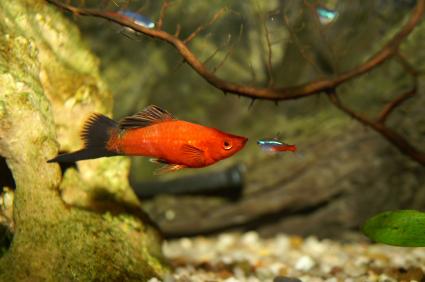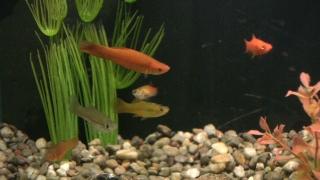Swordtails

Swordtails (Xiphophorus helleri) are colorful liverbearers that are easy to keep in an aquarium. Just as the name livebearers decribes, these fish bear their young alive and do not lay eggs.
Swordtails are from Mexico. Both the male and female of this species are similar in coloration, however, the male has a "sword" extending from the lowermost portion of his tail. Hence, the name swordtails. The female does not have this. Both males and females of this species are of similar size (around 2-3.5 inches long) with the female being only slightly larger. Swordtails may be green, orange, red, black (usually mixed with another color), or yellow.

Swordtails readily eat dried food, such as dried tropical flakes, and they will also eat insects, tubifex worms, bloodworms, small crustaceans, such as brine shrimp, and plant matter.
Swordtails can be kept in a community tank as they are generally peaceful fish.
They prefer neutral to slightly alkaline water (pH of 7.0-7.3) and the water temperature should be between 72-79 degrees Fahrenheit or 22-26 degrees Celsius.
Swordtail Reproduction
As with any livebearing fish, it is best to have at least 2-3 females per each male because male livebearers often harass the females. Plants are also good so that the females have plenty of hiding spaces.
Swordtails are easy to breed in an aquarium. With any livebearing fish all you really need to do is to have a male and female placed together. Breeding will occur even in a community tank. Like guppies, swordtails engage in internal fertilization. The anal fin of the male is modified into an organ called the gonopodium and the male uses this to inseminate the female.
There are some interesting facts about swordtail breeding. Sometimes if there is no male present one female out of a group of swordtails will change her sex into a male. Swordtails have also been known to breed with other species of Xiphophorus. This most commonly occurs with X. maculatus, more commonly known as the platy.
You will know when your female swordtail is pregnant because of the dark gravid spot on her lower abdomen. This dark spot is the eyes of the developing fry. Swordtails are livebearing fish and the fry emerge from the female fully developed in about 4-6 weeks. Adult swordtails will eat their fry and so the fry must be separated from the adults until they are larger. Sometimes plants will camouflage baby fish, but it is safer to keep them separate from their parents.
One way to do this is to have a breeding trap. You can buy these relatively cheaply at most pet stores. They are plastic containers that you put the pregnant female swordtail in (or any livebearing fish). Don't put her into the trap until she is about to give birth. The breeding trap floats in the aquarium. The trap is separated into two compartments. The top compartment houses the pregnant female swordtail. There is a small space between the top and bottom compartments so that the fry drops through to the bottom compartment where their mother can't reach them. It is possible for the fry to swim back through this space into the top compartment, but they usually don't. After the female has finished giving birth to the fry you should remove her from the trap and place her back in the aquarium. The plastic piece that separates her from the fry should be removed from the trap and you can raise the fry for a short time in the trap. However, the water in the trap tends to get somewhat stagnant and so this isn't an ideal place to raise the fry for long. If you do raise the fry in the trap you will need to clean out the trap and replace it with water from the aquarium on a regular basis. It is best to raise the fry in their own aquarium. Because they are so small they can easily be raised for awhile in a 5-10 gallon tank of their own.
Feeding the Fry
Baby swordtails can be fed newly hatched brine shrimp, newly hatched daphnia, or they can be fed dried or liquid fry food for livebearing fish. You can find these online or at your pet store. I've successfully raised baby swordtails to adulthood using dried fry food, however, you are going to get better growth of your fry if you feed them live food as well as the dried food. Don't try to feed them adult flakes because these will be too large for their tiny mouths.
